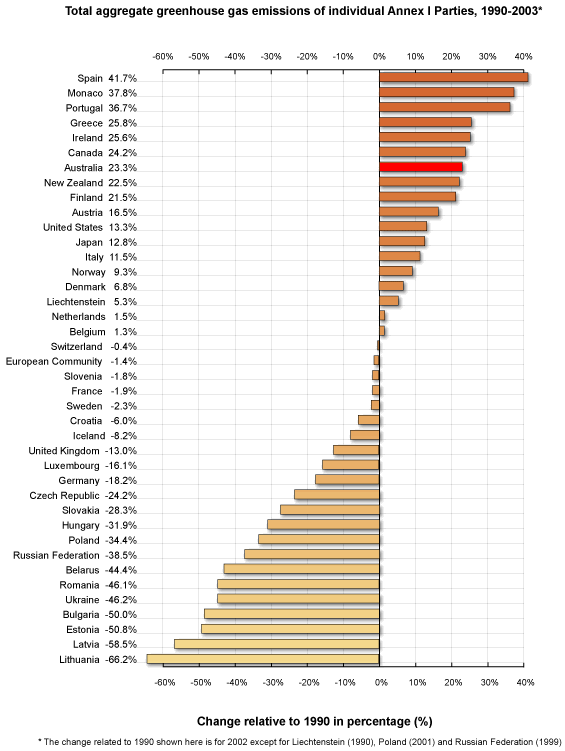|
Editorial-25 October 2006 |
| The Pale Greening of John Howard |
|
|
|
|
|
|
Way back in February 2004 the chief scientific advisor to the UK Government, Cambridge professor of chemistry, David King, delivered an urgent warning about global warming to the annual
|
|
|
Credit: United Nations Framework Convention on Climate Change (UNFCCC) |
meeting of the American Association for the Advancement of Science (AAAS). The previous month the journal Science had published in its Policy Forum section Professor King's paper Climate Change: Adapt, Mitigate, or Ignore? in which he made the observation, "In my view, climate change is the most severe problem that we are facing today--more serious even than the threat of terrorism." He was admonished by British prime minister Tony Blair for making that assessment.
Now almost three years later David King's assessment is, if anything, more true now than it was then, and from an Australian viewpoint it begins to appear that even the prime minister, John Howard, has begun to show some inclination to alter government policy in acknowledgement of the detrimental anthropogenic effect on climate change despite just last month saying he remained "sceptical about a lot of the more gloomy (climate change) predictions". Just what our climate science savvy Prime Minister categorises as the "more gloomy predictions" to which he doesn't subscribe aren't enunciated. Perhaps he could ask his staff to work up a list of what they are and who is making those predictions.
Why the apparent change? Well, this year's Lowy Institute poll found that 68% of respondents saw climate change as a "critical threat" to Australia's vital interests in the next 10 years, ahead of Islamic fundamentalism -- and the next federal election must be held on or before October 6, 2007.
And while the government under Mr Howard can not allow itself to lose face by signing up to the Kyoto Accords its commitment of $75 million toward the construction of a 154 Megawatt solar power station is a worthwhile 18% contribution to the estimated cost of construction -- the Hawthorn-based company Solar Systems estimates the cost of building the plant will be $420 million. It is expected to occupy an area of several hundred hectares.
Then in order to "housebreak" Latrobe Valley's Hazelwood coal-fired plant, listed as the worst offender for greenhouse emissions of any major power station in the country, the government will allocate $50 million. The Age reports the "refurbishment is part of a Federal Government proposal to eventually reduce the 60 million tonnes of carbon dioxide produced by brown coal power stations in the Latrobe Valley each year by up to 80 per cent."
The two initiatives still leave $375 million in the Federal Government's $500 million Low Emissions Technology Demonstration Fund, which was the main initiative of a June 2004 energy white paper and which will distribute funds over a 15 year period. How much of the remaining 75% in the fund is still available isn't clear although the smart money is betting that geosequestration will win a significant percentage while initiatives based on wind, marine wave and geothermal energy are likely to receive little.
Interestingly, the Prime Minister and the Treasurer, Peter Costello, don't appear to be quite in agreement. Mr Howard says he still believes nuclear power is also part of the solution to global warming. "While I see solar as being part of the solution, it's a solution at the periphery rather than at the centre. People have got to shift their focus onto what is going to make a contribution to the generation of base load power," while Mr Costello has made the point more than once that nuclear energy was all but inevitable, at the time it became commercially viable. (our emphasis). Furthermore, the assumption that nuclear power is a requirement for sufficient clean based power is dubious.
Incidentally, to put Solar Systems 154 Mwatt power station -- estimated to be able to power the equivalent of 45,000 homes -- into perspective, the Victorian government is investing in a $600 million wind farm is claims will generate enough electricity to power almost 190,000 homes. It will be built in western Victoria on 5500 hectares of farmland at Macarthur, near Port Fairy.
Yesterday the British High Commissioner, Helen Liddell told an audience at the University of Melbourne, "We have seen a change in the past three to four months in how the Government here looks at the issue [of climate change].
"[Britain] sees climate change and energy security as incredibly significant to the future of our country and our planet. And climate change is a reality here in Australia. The debate ceases to be abstract when you realise that the window of opportunity we have to act is only about 10 to 15 years. Climate change used to be seen as the obsession of the fringe, now it is at the heart of responsible government."
Ms Liddell stressed that international co-operation and solutions were vital and concluded by saying she believed the forthcoming release of an independent report by former World Bank chief economist Sir Nicholas Stern on the economics of climate change would probably conclude that if the costs of climate change looked worrying now, "wait and see what they will be if we do nothing".
It still remains very much a question as to whether John Howard's coalition has a genuine interest in significantly reducing Australia's contribution to climate change rather than giving just sufficient appearance so as to quell voter apprehensions. Quite apart from the actual emissions for which we are responsible the retrograde position this first world nation is seen to be taking sets an atrocious example to our region and the world.
Australia's annual greenhouse emissions amount to 560 million tonnes, estimated to be 1.4% of total global emissions. On a per capita basis Australian's are the most prolific green house gas emitters on the planet.
Alex Reisner
The Funneled Web
